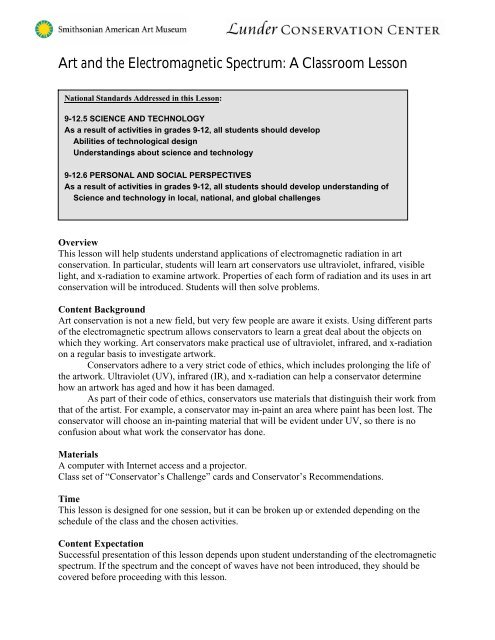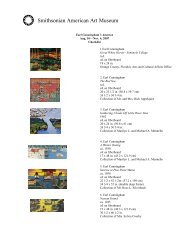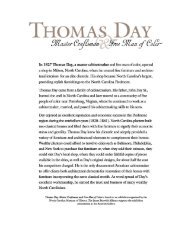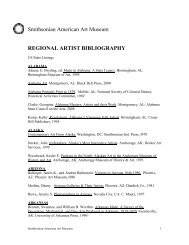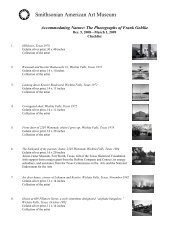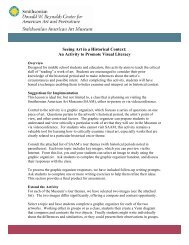Art and the Electromagnetic Spectrum: A Classroom Lesson
Art and the Electromagnetic Spectrum: A Classroom Lesson
Art and the Electromagnetic Spectrum: A Classroom Lesson
You also want an ePaper? Increase the reach of your titles
YUMPU automatically turns print PDFs into web optimized ePapers that Google loves.
<strong>Art</strong> <strong>and</strong> <strong>the</strong> <strong>Electromagnetic</strong> <strong>Spectrum</strong>: A <strong>Classroom</strong> <strong>Lesson</strong><br />
National St<strong>and</strong>ards Addressed in this <strong>Lesson</strong>:<br />
9-12.5 SCIENCE AND TECHNOLOGY<br />
As a result of activities in grades 9-12, all students should develop<br />
Abilities of technological design<br />
Underst<strong>and</strong>ings about science <strong>and</strong> technology<br />
9-12.6 PERSONAL AND SOCIAL PERSPECTIVES<br />
As a result of activities in grades 9-12, all students should develop underst<strong>and</strong>ing of<br />
Science <strong>and</strong> technology in local, national, <strong>and</strong> global challenges<br />
Overview<br />
This lesson will help students underst<strong>and</strong> applications of electromagnetic radiation in art<br />
conservation. In particular, students will learn art conservators use ultraviolet, infrared, visible<br />
light, <strong>and</strong> x-radiation to examine artwork. Properties of each form of radiation <strong>and</strong> its uses in art<br />
conservation will be introduced. Students will <strong>the</strong>n solve problems.<br />
Content Background<br />
<strong>Art</strong> conservation is not a new field, but very few people are aware it exists. Using different parts<br />
of <strong>the</strong> electromagnetic spectrum allows conservators to learn a great deal about <strong>the</strong> objects on<br />
which <strong>the</strong>y working. <strong>Art</strong> conservators make practical use of ultraviolet, infrared, <strong>and</strong> x-radiation<br />
on a regular basis to investigate artwork.<br />
Conservators adhere to a very strict code of ethics, which includes prolonging <strong>the</strong> life of<br />
<strong>the</strong> artwork. Ultraviolet (UV), infrared (IR), <strong>and</strong> x-radiation can help a conservator determine<br />
how an artwork has aged <strong>and</strong> how it has been damaged.<br />
As part of <strong>the</strong>ir code of ethics, conservators use materials that distinguish <strong>the</strong>ir work from<br />
that of <strong>the</strong> artist. For example, a conservator may in-paint an area where paint has been lost. The<br />
conservator will choose an in-painting material that will be evident under UV, so <strong>the</strong>re is no<br />
confusion about what work <strong>the</strong> conservator has done.<br />
Materials<br />
A computer with Internet access <strong>and</strong> a projector.<br />
Class set of “Conservator’s Challenge” cards <strong>and</strong> Conservator’s Recommendations.<br />
Time<br />
This lesson is designed for one session, but it can be broken up or extended depending on <strong>the</strong><br />
schedule of <strong>the</strong> class <strong>and</strong> <strong>the</strong> chosen activities.<br />
Content Expectation<br />
Successful presentation of this lesson depends upon student underst<strong>and</strong>ing of <strong>the</strong> electromagnetic<br />
spectrum. If <strong>the</strong> spectrum <strong>and</strong> <strong>the</strong> concept of waves have not been introduced, <strong>the</strong>y should be<br />
covered before proceeding with this lesson.
Procedure<br />
Refresh or present <strong>the</strong> concept of electromagnetic spectrum. This lesson focuses primarily on<br />
UV, visible light, IR <strong>and</strong> x-radiation.<br />
1. Begin by introducing students to <strong>the</strong> concept of art conservation by showing <strong>the</strong>m <strong>the</strong> video at<br />
http://americanart.si.edu/lunder/video.cfm?key=9&subkey=1206 (This feature requires <strong>the</strong> QuickTime<br />
Player, a browser plug-in that your technology coordinator can install for you if you do not already have it.)<br />
2. After <strong>the</strong> video, lead a discussion about art conservation. The profession is an interesting intersection of<br />
chemistry, physics, history, <strong>and</strong> <strong>the</strong> fine arts. Students may discuss <strong>the</strong> challenges that conservators might<br />
face. Possible discussion questions include <strong>the</strong> following:<br />
a. What are <strong>the</strong> skills that someone would need to be a conservator?<br />
b. What sort of challenges do you think conservators face?<br />
c. In <strong>the</strong> video, <strong>the</strong> painting conservator said that <strong>the</strong> materials used for in-painting should<br />
be reversible. Why is that?<br />
3. Discuss <strong>the</strong> uses of different types of radiation. You may ei<strong>the</strong>r start with visible light (i.e., What could a<br />
conservator see with <strong>the</strong> naked eye that might tell him that materials have aged?) or <strong>the</strong> UV example given<br />
in <strong>the</strong> movie. (Why is UV radiation able to reveal previous conservation work done on a painting?) This<br />
discussion should probe what each wavelength does.<br />
a. X-rays are located on <strong>the</strong> electromagnetic spectrum between ultraviolet <strong>and</strong> gamma rays. The depth<br />
of penetration of x-rays through a material depends on its density. A common use of x-rays in<br />
museums is to photograph density variations in composite materials, i.e., to examine painting pigments<br />
<strong>and</strong> sculpture structures. 1 For example, if a ceramic sculpture is suspected of having a crack, an x-ray<br />
will be taken to determine <strong>the</strong> severity of <strong>the</strong> crack.<br />
b. Ultraviolet radiation has waves just a bit shorter than visible light. Ultraviolet radiation, also<br />
referred to as ultraviolet light, is used generally in conservation to differentiate types of paints. For<br />
example, newer in-painting will appear dark under UV light, making it easier for <strong>the</strong> conservator to<br />
identify. Similarly, some varnishes <strong>and</strong> pigments will fluoresce or phosphoresce differently depending<br />
on <strong>the</strong> chemical make-up of <strong>the</strong> substance, <strong>the</strong>reby helping <strong>the</strong> conservator identify <strong>the</strong> material in <strong>the</strong><br />
artwork.<br />
c. Visible light can be seen with <strong>the</strong> naked eye. Discoloration, pigment change, <strong>and</strong> structural damage<br />
are often first seen this way.<br />
d. Infrared radiation can reveal an underdrawing that lies below <strong>the</strong> paint surface. Conservators will<br />
often use infrared reflectography, which is set up as a closed-circuit television system. A light source is<br />
directed at <strong>the</strong> painting, <strong>and</strong> <strong>the</strong> camera detects reflected infrared radiation. This signal is converted<br />
into a black <strong>and</strong> white image on a television monitor. Underdrawings executed in infrared-absorbing<br />
materials, such as black chalk or bone black, will appear dark on <strong>the</strong> screen, because <strong>the</strong>y do not reflect<br />
infrared light. 2<br />
4. Now that students have a brief underst<strong>and</strong>ing of what tools conservators use, <strong>the</strong>y can meet <strong>the</strong> challenges<br />
that conservators face. Break students into manageable groups (preferably of 3 or 4). Each group will be<br />
presented with three “Conservator’s Challenge Cards,” which present conservation problems. They will<br />
<strong>the</strong>n write three recommendations, one for each challenge. (These worksheets are attached.)<br />
5. After all groups have completed <strong>the</strong>ir recommendations, share <strong>the</strong> results (also attached) with <strong>the</strong> class.<br />
Discuss why <strong>the</strong> correct radiation was <strong>the</strong> best solutions for each problem.<br />
1 CAMEO: Consevation & <strong>Art</strong> Material Encyclopedia Online<br />
http://cameo.mfa.org/index.asp<br />
2 Spronk, R. (n.d.) Investigating <strong>the</strong> Renaissance. Retrieved September 9, 2008, from The Fogg Museum’s<br />
Investigating <strong>the</strong> Renaissance Site: http://www.artmuseums.harvard.edu/Renaissance/iframes.html
Conservator Challenge Card #1<br />
This portrait of Judith Langley has been brought to<br />
your conservation lab. There is a heavy coat of varnish on<br />
<strong>the</strong> surface that shows discoloration in visible light. The<br />
texture of <strong>the</strong> surface of <strong>the</strong> painting <strong>and</strong> <strong>the</strong> thickness of<br />
<strong>the</strong> discolored varnish leads you to believe <strong>the</strong>re might be<br />
something hidden beneath <strong>the</strong> layers of varnish in <strong>the</strong><br />
upper left-h<strong>and</strong> corner of <strong>the</strong> portrait. What might you<br />
use to find out if <strong>the</strong>re is something underneath?<br />
Judith Langley<br />
n.d.<br />
Attributed to Jan Anthonisz van Ravesteyn<br />
oil on canvas<br />
23 x 19 in. (58.4 x 48.3 cm.)<br />
Smithsonian American <strong>Art</strong> Museum<br />
Bequest of Mabel Johnson Langhorne
Conservator Challenge Card #2<br />
A group of siblings has graciously offered to donate a<br />
family portrait to <strong>the</strong> museum in memory of <strong>the</strong>ir mo<strong>the</strong>r.<br />
Scholars have confirmed that <strong>the</strong> painting is by John<br />
Smibert, a famous early American colonial portraitist.<br />
Examination in visible light makes you think <strong>the</strong>re is<br />
discolored varnish on <strong>the</strong> surface of <strong>the</strong> painting. You<br />
would also like to check more closely for paint loss <strong>and</strong><br />
previous conservation. What would you use to find out?<br />
A Member of <strong>the</strong> Livingston Family<br />
1740’s<br />
John Smibert<br />
oil on canvas<br />
42 x 30 in. (106.7 x 76.2 cm)<br />
Smithsonian American <strong>Art</strong> Museum<br />
Gift of <strong>the</strong> Amirkhan children in memory of <strong>the</strong>ir<br />
mo<strong>the</strong>r, Babette Keeler Amirkhan, Educator, <strong>and</strong><br />
Livingston Family Descendant
Conservator Challenge Card #3<br />
Museums often loan artwork to o<strong>the</strong>r places. In this<br />
case, <strong>the</strong> sculpture Glory, Glory pictured left has been<br />
requested for a multi-venue loan. That means that it will<br />
travel to many places. Before this is packaged <strong>and</strong> sent,<br />
you must be sure that <strong>the</strong>re are no cracks or structural<br />
damage that you cannot see. How might you find out?<br />
Glory, Glory<br />
1938<br />
Viktor Schrekengost<br />
modeled <strong>and</strong> glazed terra cotta with engobe<br />
18 5/8 x 10 3/8 x 9 in. (47.3 x 26.3 x 22.9 cm.)<br />
Smithsonian American <strong>Art</strong> Museum<br />
Gift of <strong>the</strong> artist
Conservator’s Recommendations<br />
What form of electromagnetic radiation would you use to solve each challenge? Be sure to include why that particular radiation will<br />
help solve <strong>the</strong> challenge.<br />
Challenge # What type of electromagnetic radiation? How will that type radiation help you?<br />
1.<br />
2.<br />
3.
Conservator’s Recommendations<br />
What form of electromagnetic radiation would you use to solve each challenge? Be sure to include why that particular radiation will<br />
help solve <strong>the</strong> challenge.<br />
Challenge # What type of electromagnetic radiation? How will that type radiation help you?<br />
1.<br />
Infrared radiation (IR)<br />
IR will allow me to see if <strong>the</strong>re are underlying drawings<br />
(underdrawings) beneath <strong>the</strong> surface of <strong>the</strong> painting.<br />
2.<br />
Ultraviolet Radiation (UV)<br />
In-painting (or previous conservation) could show up as dark areas<br />
under UV light, allowing me to see differences from <strong>the</strong> original paint.<br />
3. X-radiation<br />
X-rays will allow me to see if <strong>the</strong>re are any damages to <strong>the</strong> structure of<br />
<strong>the</strong> sculpture. The x-rays allow me to see <strong>the</strong> differences in density to<br />
find places in <strong>the</strong> sculpture that need special packing care.
The Results<br />
#1 IR! That’s right, infrared radiation helped conservators at <strong>the</strong> Smithsonian American<br />
<strong>Art</strong> Museum see a coat of arms that was hidden beneath layers of discolored varnish.<br />
Check out <strong>the</strong> pictures!<br />
Before Conservation<br />
Infrared<br />
After Conservation Treatment<br />
(after removal of discolored varnish)<br />
Attributed to Jan Anthonisz van Ravesteyn, (no date), Judith Langley, oil on canvas, 23 x 19 in. (58.4 x 48.3 cm.),<br />
Smithsonian American <strong>Art</strong> Museum, Bequest of Mabel Johnson Langhorne
The Results<br />
#2 UV! Ultraviolet radiation allowed conservators at <strong>the</strong> Smithsonian American <strong>Art</strong><br />
Museum to identify discolored varnish <strong>and</strong> areas of in-painting.<br />
Before Treatment<br />
Under Ultraviolet<br />
The Results<br />
John Smibert, 1740’s, A Member of <strong>the</strong> Livingston Family, oil on canvas, 42 x 30 in. (106.7 x 76.2 cm),<br />
Smithsonian American <strong>Art</strong> Museum, Gift of <strong>the</strong> Amirkhan children in memory of <strong>the</strong>ir mo<strong>the</strong>r, Babette Keeler Amirkhan,<br />
Educator, <strong>and</strong> Livingston Family Descendants
#3 X-ray! X-radiation allowed conservators at <strong>the</strong> Smithsonian American <strong>Art</strong> Museum to<br />
look for cracks <strong>and</strong> areas of weakness in <strong>the</strong> sculpture. Just like in a medical x-ray, <strong>the</strong><br />
dense places are white <strong>and</strong> <strong>the</strong> less dense places are black. The conservators could tell<br />
that <strong>the</strong> heads <strong>and</strong> arms were hollowed out. The line through <strong>the</strong> center of <strong>the</strong> sculpture<br />
means that it was created in two pieces. A special crate will be made in order to ship <strong>the</strong><br />
sculpture.<br />
Viktor Schrekengost, Glory, Glory, 1938, modeled <strong>and</strong> glazed terra cotta with engobe, 18 5/8 x 10 3/8 x 9 in. (47.3 x 26.3 x 22.9<br />
cm.), Smithsonian American <strong>Art</strong> Museum, Gift of <strong>the</strong> artist


